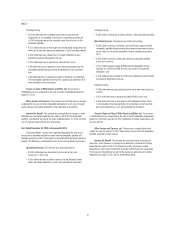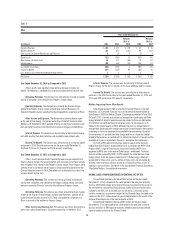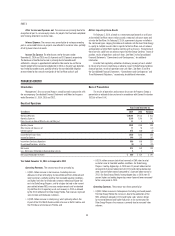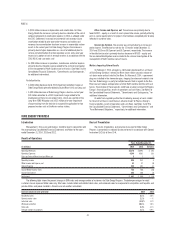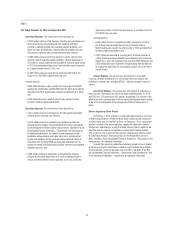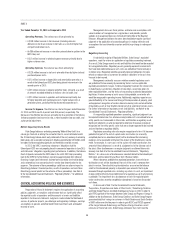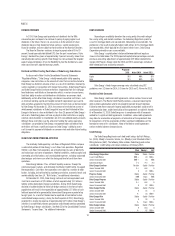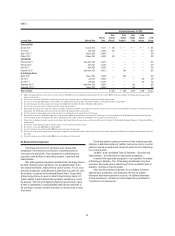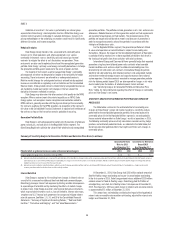Duke Energy 2014 Annual Report Download - page 66
Download and view the complete annual report
Please find page 66 of the 2014 Duke Energy annual report below. You can navigate through the pages in the report by either clicking on the pages listed below, or by using the keyword search tool below to find specific information within the annual report.
46
PART II
Year Ended December 31, 2014 as Compared to 2013
Operating Revenues. The variance was driven primarily by:
• A $138 million increase in fuel revenues (including emission
allowances) due to an increase in fuel rates as a result of higher fuel
and purchased power costs;
• An $86 million net increase in rate riders primarily due to updates to the
IGCC rider; and
• A $17 million increase in wholesale power revenues primarily due to
higher customer rates.
Operating Expenses. The variance was driven primarily by:
• A $128 million increase in fuel costs primarily driven by higher fuel and
purchased power costs;
• A $71 million increase in depreciation and amortization primarily as a
result of the Edwardsport IGCC plant being placed into service in the
second quarter of 2013;
• A $57 million increase in property and other taxes, primarily as a result
of amounts recorded related to an Indiana sales tax audit; and
• A $21 million increase in operation and maintenance primarily due
to higher operation and maintenance costs, higher outage costs at
generation plants, partially offset by decreased corporate costs.
Income Tax Expense. The effective tax rate for the years ended December
31, 2014 and 2013 was 35.5 percent and 38.4 percent, respectively. The
decrease in the effective tax rate was primarily due to a reduction in the Indiana
statutory corporate state income tax rate, a more favorable state tax credit, and
a prior period adjustment.
Matters Impacting Future Results
Duke Energy Indiana is evaluating converting Wabash River Unit 6 to a
natural gas-fi red unit or retiring the unit earlier than its current estimated useful
life. If Duke Energy Indiana elects early retirement of the unit, recovery of remaining
book values and associated carrying costs totaling approximately $40 million could
be subject to future regulatory approvals and therefore cannot be assured.
In 2015, the IURC is examining intervenors’ allegations that the
Edwardsport IGCC was not properly placed in commercial operation in June 2013
and intervenors’ allegations regarding plant performance. In addition, the Indiana
Court of Appeals remanded the IURC order in the ninth IGCC rider proceeding
back to the IURC for further fi ndings concerning approximately $61 million of
fi nancing charges Joint Intervenors claimed were caused by construction delay
and a ratemaking issue concerning the in-service date determination for tax
purposes. The outcome of these proceedings could have an adverse impact to
Duke Energy Indiana’s fi nancial position, results of operations and cash fl ows.
Duke Energy cannot predict on the outcome of these proceedings. See Note 4
to the Consolidated Financial Statements, “Regulatory Matters,” for additional
information.
CRITICAL ACCOUNTING POLICIES AND ESTIMATES
Preparation of fi nancial statements requires the application of accounting
policies, judgments, assumptions and estimates that can signifi cantly affect
the reported results of operations and the amounts of assets and liabilities
reported in the fi nancial statements. Judgments made include the likelihood of
success of particular projects, possible legal and regulatory challenges, earnings
assumptions on pension and other benefi t fund investments and anticipated
recovery of costs.
Management discusses these policies, estimates and assumptions with
senior members of management on a regular basis and provides periodic
updates on management decisions to the Audit Committee of the Board of
Directors. Management believes the areas described below require signifi cant
judgment in the application of accounting policy or in making estimates and
assumptions that are inherently uncertain and that may change in subsequent
periods.
Regulatory Accounting
A substantial majority of Regulated Utilities, Duke Energy’s regulated
operations, meet the criteria for application of regulatory accounting treatment.
As a result, Duke Energy records assets and liabilities that would not be recorded
for nonregulated entities. Regulatory assets generally represent incurred costs
that have been deferred because such costs are probable of future recovery in
customer rates. Regulatory liabilities generally represent obligations to make
refunds or reduce rates to customers for previous collections or for costs that
have yet to be incurred.
Management continually assesses whether recorded regulatory assets
are probable of future recovery by considering factors such as applicable
regulatory environment changes, historical regulatory treatment for similar costs
in Duke Energy’s jurisdictions, litigation of rate orders, recent rate orders to
other regulated entities, and the status of any pending or potential deregulation
legislation. If future recovery of costs ceases to be probable, asset write-offs
would be recognized in operating income. Additionally, regulatory agencies can
provide fl exibility in the manner and timing of the depreciation of property, plant
and equipment, recognition of nuclear decommissioning costs and amortization
of regulatory assets or may disallow recovery of all or a portion of certain assets.
For further information on regulatory assets and liabilities, see Note 4 to the
Consolidated Financial Statements, “Regulatory Matters.”
As required by regulated operations accounting, signifi cant judgment can
be required to determine if an otherwise recognizable cost is considered to be an
entity specifi c cost recoverable in future rates and therefore a regulatory asset.
Signifi cant judgment can also be required to determine if revenues previously
recognized are for entity specifi c costs that are no longer expected to be incurred
and are therefore a regulatory liability.
Regulatory accounting rules also require recognition of a loss if it becomes
probable that part of the cost of a plant under construction (or a recently
completed plant or an abandoned plant) will be disallowed for ratemaking
purposes and a reasonable estimate of the amount of the disallowance can be
made. For example, if a cost cap is set for a plant still under construction, the
amount of the disallowance is a result of a judgment as to the ultimate cost of
the plant. Other disallowances can require judgments on allowed future rate
recovery. See Note 4 to the Consolidated Financial Statements, “Regulatory
Matters,” for a discussion of disallowances recorded related to the Edwardsport
IGCC plant and the retired Crystal River Unit 3 Nuclear Station.
When it becomes probable that regulated generation, transmission or
distribution assets will be abandoned, the cost of the asset is removed from
plant in service. The value that may be retained as an asset on the balance
sheet for the abandoned property is dependent upon amounts that may be
recovered through regulated rates, including any return. As such, an impairment
charge could be offset by the establishment of a regulatory asset if rate recovery
is probable. The impairment for a disallowance of costs for regulated plants
under construction, recently completed or abandoned is based on discounted
cash fl ows.
As discussed in Note 2 to the Consolidated Financial Statements,
“Acquisitions, Dispositions and Sales of Other Assets,” Duke Energy Carolinas
and Duke Energy Progress recorded disallowance charges in 2012 in order to
gain FERC approval of the merger between Duke Energy and Progress Energy. In
addition to the disallowances, Duke Energy Carolinas and Duke Energy Progress
guaranteed total fuel savings to customers in North Carolina and South Carolina
of $687 million over the fi ve years in order to gain NCUC and PSCSC approval
of the merger between Duke Energy and Progress Energy. Based on current
estimates of future fuel costs, Duke Energy anticipates that it will meet the



